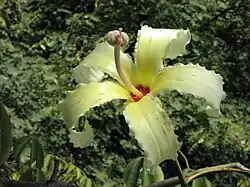Ceiba ventricosa
| Ceiba ventricosa | |
|---|---|

| |
| Scientific classification | |
| Kingdom: | Plantae |
| Clade: | Tracheophytes |
| Clade: | Angiosperms |
| Clade: | Eudicots |
| Clade: | Rosids |
| Order: | Malvales |
| Family: | Malvaceae |
| Genus: | Ceiba |
| Species: | C. ventricosa
|
| Binomial name | |
| Ceiba ventricosa (Nees & Mart.) Ravenna
| |
| Synonyms[1] | |
| |
Ceiba ventricosa, known as the barriguda tree, is a species of tree in the Malvaceae family. It is a tropical and evergreen species native to the Atlantic rainforests of Brazil. It can reach a height of 26 meters, and the bole can grow to a diameter of 60 centimeters.[2] The species was described by Pedro Felix Ravenna in 1998.[3]
Uses
The timber is harvested, but is of low quality.[2] The wood is used by the Aimoré people of Brazil as a wooden plug or disk which is worn in the lower lip and the lobe of the ear.[4]
References
- ^ "Ceiba ventricosa (Arruda ex Nees & Mart.) Ravenna". www.gbif.org. Retrieved 10 July 2022.
- ^ a b "Ceiba ventricosa – Useful Tropical Plants". tropical.theferns.info. Retrieved 10 July 2022.
- ^ "CAUDICIFORM Ceiba ventricosa". Bihrmann's Caudiciforms. Retrieved 10 July 2022.
- ^ One or more of the preceding sentences incorporates text from a publication now in the public domain: Chisholm, Hugh, ed. (1911). "Botocudos". Encyclopædia Britannica. Vol. 4 (11th ed.). Cambridge University Press. pp. 304–305.